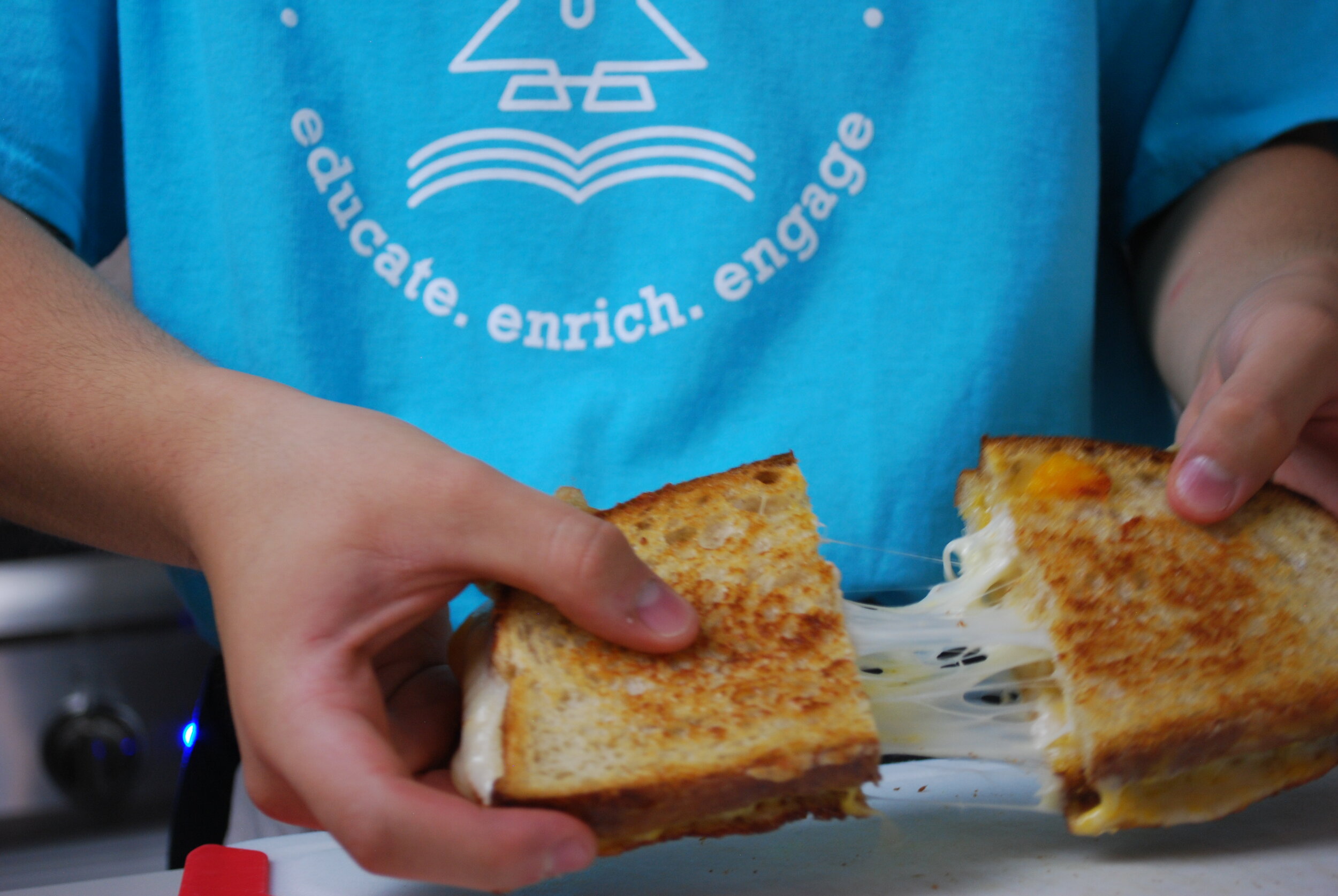Perfect Grilled Cheese
Learn the delicious science of how cheese melts while enjoying a tasty afternoon classic.
Materials
2 slices of Sourdough bread
2 tsp unsalted butter
1 slice of cheddar cheese
1 slice of White cheddar cheese
1 slice of low moisture mozzarella
Procedure
Step 1
Butter both sides of the sourdough bread with the butter and place in a medium low heat pan.
Step 2
Brown one side until golden brown 4-5 minutes, flip over.
Step 3
Layer all of the cheeses onto one side of the bread and close the sandwich.
Step 4
Brown each side for 3 minutes each or until golden brown on both sides.
STEP 5
Remove from heat and cut in half. Enjoy!
Science Explanation
WHY IS THIS THE PERFECT GRILLED CHEESE? These cheeses were chosen for a reason! The cheddars are high in fat and are aged to provide deep flavor as well as the perfect melt and mouthfeel. The mozzarella, which is high in fat, acid, and water, creates the perfect melting cheese for the stringy pull when you bite into it. Together, the deep flavored fatty cheeses paired with the buttery crust and tangy sourdough creates an explosion of flavor - which is why grilled cheese is one of the most popular comfort foods around!
Kindergarten - 2nd Grade . . .
- The amount of fat in a cheese gives its ability to melt. A cheese high in fat has a lower melting point (the point where a heated solid becomes a liquid) which allows for smooth and silky melts.
- Some examples of high fat cheese include Cheddar, colby, or swiss. While lower fat cheeses include, ricotta, cottage, and mozzarella. However, cheeses high in acids like swiss cheese melt into stringy messes.
- When you heat cheese it begins to melt and turn into a liquid, if you cooled the cheese would it stay a liquid or go back to a solid?
- The cheese when heated melts into a liquid, when it cools it returns back into a solid. But, there is a problem, when cheese is melted so does the fat. The fat begins to seep out of the cheese, impacting the flavor if you eat it once it's cold. It becomes less creamy and more grainy.
- Touch the different cheeses. Is there a difference in how they feel?
- There is a difference in feeling when you touch the cheddar versus the Mozzarella, the cheddar is rougher and when you bend it it immediately snaps, while the mozzarella is smooth to touch and is more bendable. 2-PS1-4
- The cheddar has a different fat content than the mozarella, what are the strengths and weaknesses of both cheeses?
- There are many strengths and weaknesses between the two cheeses, flavor wise the cheddar has more fat and is normally aged making it generaly tastier. The mozzarella is way better at stretching and sticking together so it looks better. The many strengths of the cheeses help to create a tasty snack. K-2-ETS1-3
3rd - 5th Grade . . .
- When cheese is heated to about 90℉, two things begin to happen. First, the solid milk fat begins to liquify and begins softening the cheese. As more heat is used, a protein in the cheese called casein begins to break apart. After enough of this happens, the solid structure of the cheese begins to collapse and causes the cheese to become a thick liquid. But, not all cheeses melt the same or at the same temperature.Softer cheeses like mozzarella are fully melted at around 130℉, aged cheeses like cheddar at 150℉, and hard cheese like parmesan at 180℉.
- If you were creating a sandwich that all that mattered was flavor, which cheeses would you use? What if all you wanted was the cheese pull?
- If all you cared about was flavor you would make grilled cheese with only cheddars or harder cheeses because they provide the most flavor and overall aroma. If all you wanted was a really good cheese pull, you would use the mozzarella, because how the cheese is structured makes it the best cheese to stretch. 3-5-ETS1-2
- Based on the observable properties of the cheeses, can you determine which ones are which?
- Just by visuals, the orange cheddar is obviously different from the white cheddar and mozzarella. But this begs the question, how do you tell the white cheddar apart from the mozzarella? Well, the white cheddar and mozzarella do have very similar color, but the difference is in the texture. The cheddar has a rougher and less smooth texture than the mozzarella, and if you bend the cheddar it snaps super easy, while the mozzarella is much more flexible and does not snap as easily. 5-PS1-3
6th - 8th Grade . . .
- There are two properties that affect the hardness of cheeses: water content and density of casein proteins. The more water in a cheese, the softer it is. Casein is a protein that holds the structure of a cheese. The more softly packed the casein proteins, the softer the cheese.
- In a softer cheese like Mozzarella, the casein proteins are more loosely packed with lots of water interspersed within them, so when heated they soften and melt readily. On the other hand, harder cheeses like a cave aged parmesan, have less water interspersed within the proteins making it less easy to melt and soften.
- In order for cheese to hold its shape there is a glue made of calcium that holds the protein molecules together.When heated, this glue begins to break and casein molecules begin to separate.
- If you take a look at the proteins of a fresh unaged cheese, the casein proteins are long and stretchy, which is why when you melt mozzarella it is super stringy. On the other hand, with aged cheeses like cheddar, the casein proteins are attacked by enzymes needed for ageing. So, the stringy proteins are cut up into small pieces. When it melts it has no elasticity, it only melts smoothly.
Math Extensions
Kindergarten
- How many pieces of bread do we have? What about cheese? CCSS.MATH.CONTENT.K.CC.B.5
- Which is bigger: the bread or the cheese? CCSS.MATH.CONTENT.K.MD.A.2
1st Grade
- What shape is the cheese? What about the Bread? (Answer: Cheese is a square because it has four sides of the same length. The bread is more like a rectangle but it has a rounded top.) CCSS.MATH.CONTENT.1.G.A.1
- We have the stick of butter, the cheese, and the bread, put them in order of tallest to shortest. CCSS.MATH.CONTENT.1.MD.A.1
2nd Grade
- In inches how long are each of the objects? Give your best approximation.
- Answer: The bread is around 8-9 inches because it's the largest out of all the items, but it's not as big as a foot or a meter. The cheese is about 4-5 inches, and are squares, while the butter as the smallest would be around 3 centimeters. CCSS.MATH.CONTENT.2.MD.A.3
- If we had a square of cheese that has one side length of 3 inches what would be the perimeter? Why?
- Answer: Your perimeter would be 12 inches because a square has four sides of the same length, so we have four sides that are 3 inches each. And the perimeter is length + width + length + width so when we add 3 + 3 + 3 +3= we get a perimeter of 12 inches. CCSS.MATH.CONTENT.3.MD.D.8
3rd Grade
- What would happen if we cut the cheese in half, what about in half again? What would the fraction be?
- Answer: The fraction if we cut the cheese in half would be ½ because we now have 2 parts of one hole. If we took the 2 halves and put them back together we would get the whole piece of cheese. If we took the halves and cut them in half again we would get fourths, or ¼. If we took 2 of the fourths, then we would have ½ because 2/4 is equal to ½. CCSS.MATH.CONTENT.3.NF.A.3.B
4th Grade
- Find the area of the square of cheese by measuring the length and width. CCSS.MATH.CONTENT.4.MD.A.3
- Answer: Well, because we know that the cheese is a square if we find one of the side lengths we can find the area. Let’s say that you measured the square and the side length is 3 inches, to find the area we multiply the length by the width and that's the area, so 3 x 3 = 9 so the area of that piece of cheese is 9 inches squared.
- Use a protractor to measure the angles of the cheese, what do these angles tell you about the shape of the cheese. CCSS.MATH.CONTENT.4.MD.C.6
- Answer: If you have a standard slice of cheese, the corners are most likely 90 degrees on each side. What shape has four 90 degree angles? That’s right! A square or a rectangle.
5th Grade
- Find the volume of your stick of butter, by measuring its length, width, and height. CCSS.MATH.CONTENT.5.MD.C.5.B
- Answer: If your butter had a length of 2 inches, a width of 2 inches, and height of 5 inches, can you solve it to find the volume of the stick. Well, the formula is Length x Width x Height= Volume so 2 x 2 x 5= 20inches cubed.
Written by Ryan Okajima Inspired by Fine Cooking







